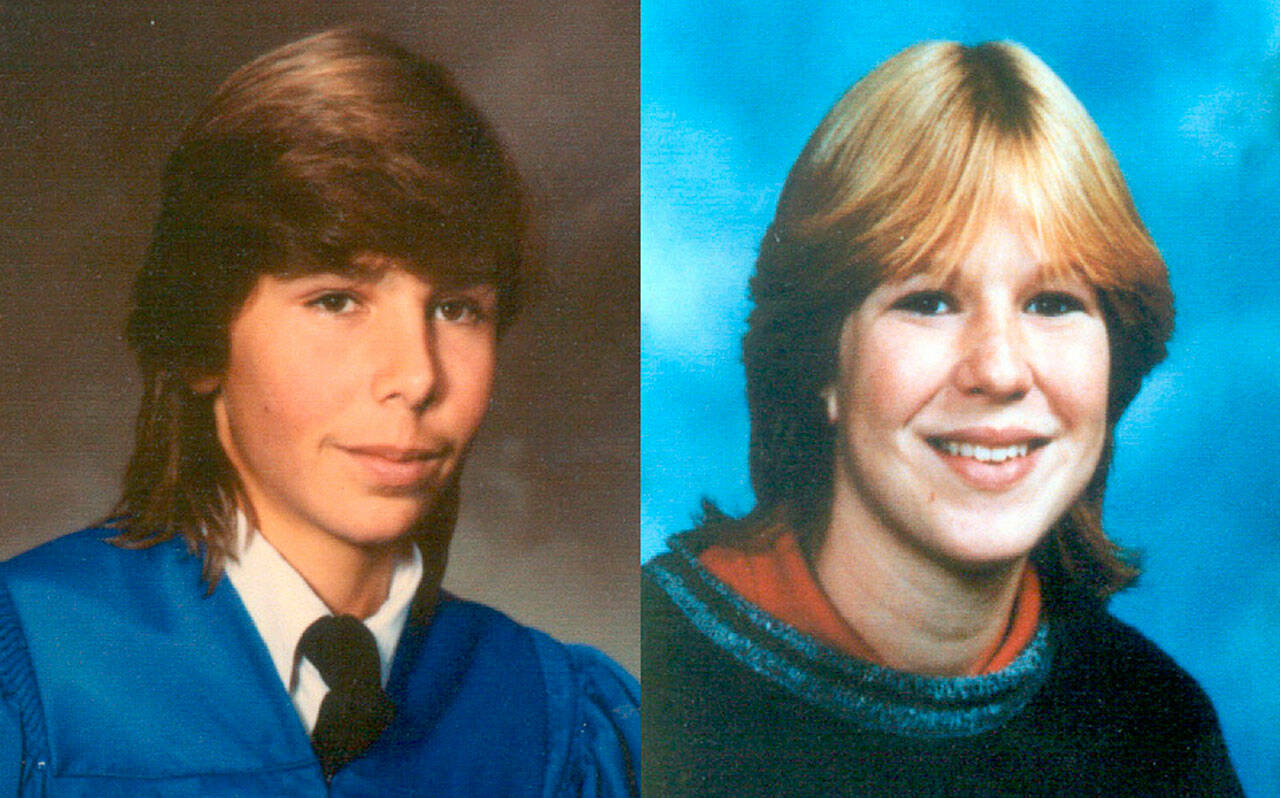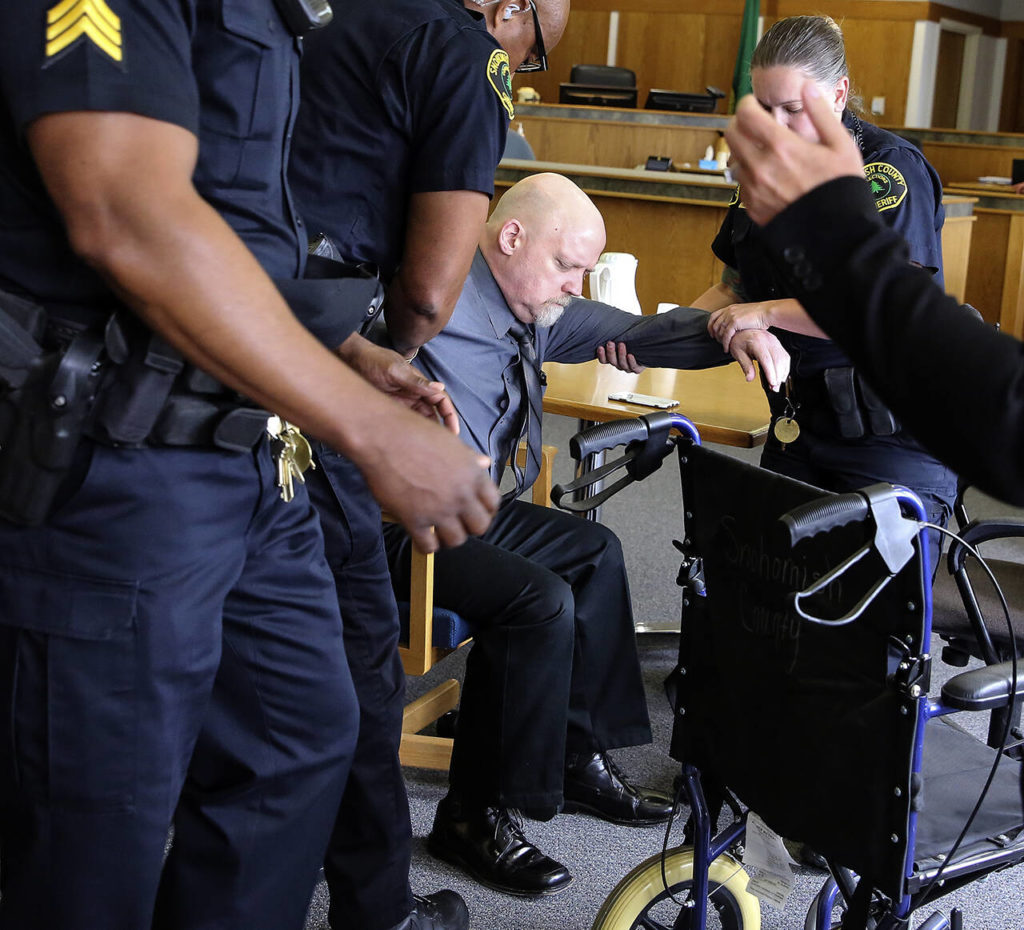EVERETT — In a unanimous decision Thursday, the state Supreme Court reinstated two aggravated murder convictions for William Talbott II, in the landmark cold case that put “forensic genealogy” in front of a jury for the first time in the United States.
The case is now expected to return to the state Court of Appeals to address other legal questions raised by the defendant.
After 30 years of dead ends, public DNA ancestry databases and genealogical research led to a breakthrough in the case of slain Canadian couple Jay Cook, 20, and Tanya Van Cuylenborg, 18. A well documented investigation, arrest and trial culminated in a Snohomish County jury convicting Talbott, now 59, of killing the pair in 1987.
But legal arguments over one juror’s perceived bias led the state Court of Appeals to overturn the convictions in late 2021. Snohomish County prosecutors appealed that ruling to the state’s highest court. None of the arguments at issue centered on the pioneering DNA sleuthing.
Cook and Van Cuylenborg left Vancouver Island in a bronze Ford Club Wagon van to run an errand for the Cook family business on Nov. 18, 1987. They never arrived at their destination south of downtown Seattle. Passersby found their bodies days later, separately, along rural roads about 65 miles apart, on the week of Thanksgiving. The van had been abandoned farther north in downtown Bellingham. Inside was a ticket for the Bremerton-Seattle ferry stamped 10:16 p.m. Nov. 18.
Three decades later, cold case investigators renewed their efforts to solve the case, sending semen samples from the presumed rapist and killer to Parabon NanoLabs, a private lab in Virginia willing to test out a few new tactics to help solve the case. After a genetic profile was uploaded to the public ancestry database GEDmatch, genealogist CeCe Moore quickly traced the unknown suspect’s family trees. The maternal and paternal family lines intersected in a Woodinville family. The Talbotts had only one son, who went by “Bill.”
It was the first time detectives had heard of William Talbott, a SeaTac trucker who grew up about 7 miles west of High Bridge, where a hunter discovered Cook’s strangled and battered body south of Monroe. Detectives believe Talbott and the young couple were strangers to each other.
Just as police zeroed in on the suspect, the same DNA ancestry database technique led to the arrest of the so-called Golden State Killer. Since then, Snohomish County sheriff’s detectives and death investigators have used forensic genealogy to crack about a dozen cases of unidentified remains — and several homicide cold cases.
Police put Talbott under surveillance until a coffee cup fell from his work truck in south Seattle. Officers quietly swiped it to test the saliva on the rim for DNA. A state crime lab found it was an apparent match for the crime scene DNA from 1987.
The trial drew coverage from the New York Times, Wired and national TV programs. It also became the subject of a book written by Pulitzer Prize winner Edward Humes.
Yet in spite of the spotlight on forensic genealogy, defense attorneys never challenged its legality or the science behind it. The appeal hinged on the seating of juror No. 40.
[Click here for a behind-the-scenes look at The Herald’s past coverage of this case.]
Under questioning in jury selection, the woman expressed doubts about her ability to be impartial due to the nature of the case. According to transcripts, she said: “If it’s a case involving violence and women, it’s just something that I’ve already experienced in my life, and I fear that I will always inherently have as a mother, so that’s just the one thing that I probably couldn’t get past.”
Still, she said she would try to be fair.
She later continued: “There’s always multiple sides to a story, and I’m a fact-based person, so I could tell you that I will give it my very best, should I end up being on the jury, to do that. I just wanted to point this out to you, in case, in how you make your determination, that’s a factor, you know. I’m an emotional being, like all of us, so it’s just — the potential is there.”
Snohomish County Superior Court Judge Linda Krese, who has since retired, did not dismiss the juror. Talbott’s two defense attorneys did not use one of their three “peremptory challenges” to have the juror excused without needing to give a reason.
After three days of jury deliberation ended in guilty verdicts, Krese ordered Talbott to serve life in prison, the only possible sentence allowed under state law for aggravated murder, since the death penalty has been struck down by the state Supreme Court.
The high court heard oral arguments in State v. Talbott in September, where a key question was whether the juror showed “actual bias,” as the Court of Appeals had found. In appeal paperwork, Snohomish County prosecutors had cited a past state Supreme Court ruling: “a mere possibility of bias is not sufficient to prove actual bias; rather the record must demonstrate that there was a probability of actual bias.”
“Our position is, of course, saying, ‘I’ll try,’ is not enough,” Talbott’s appellate attorney Mary Swift told the justices in September.
Chief Justice Steven González noted the juror hadn’t made a statement that showed unquestionable bias or a blatant conflict of interest.
“I think some judges would have granted the ‘cause challenge’ here, and some — well, obviously, this judge didn’t,” González said. “So isn’t that a hard one for the Court of Appeals, under the RAP 2.5 analysis?”
The state’s appellate attorney Seth Fine asserted there were three possible explanations for the defense’s failure to dismiss the juror.
Option one, in an oversight, defense attorneys “forgot” to excuse the juror.
Option two, it was a tactical decision to seek a reversal on appeal, which the state’s high court ought to discourage, he said.
Or option three, and most likely in Fine’s view, the defense attorneys looked at everything and decided the juror didn’t really seem to be biased.
Meanwhile, Swift argued: “It’s the obligation of the trial court, in addition to everybody else present as well, to ensure that the defendant receives a fair trial.”
“But that’s a judicial determination,” Justice Debra Stephens cut in. “Whether the juror’s qualified to serve is a judicial determination. And that determination was made. So on this record, at the time the trial concluded, we did not have a biased juror sitting in that box, so the judge made that decision. … What is the message you want us to send to trial courts about what they must do?”
In the unusually swift ruling Thursday, justices agreed that Talbott’s defense had accepted the jury panel, including juror No. 40, and that his appeal “is foreclosed by a long line of precedent.”
“We reaffirm that if a party allows a juror to be seated and does not exhaust their peremptory challenges, then they cannot appeal on the basis that the juror should have been excused for cause,” wrote Justice Mary Yu, who authored the 9-0 decision.
Talbott has remained behind bars since he was first arrested in 2018. If the verdicts had not been reinstated, he would have faced another trial. He has been serving time at the Washington State Penitentiary in Walla Walla.
“What struck me is that common sense prevailed,” said Snohomish County Prosecutor Adam Cornell, who had just finished reading the opinion. “The defense can’t simply sit on their hands when they have an opportunity to strike a juror who they think is adverse to their client. … If you have that arrow in your quiver, you have to use it.”
Cornell, who will wrap up his term at the end of December, also said he was incredibly proud of the work of the trial attorneys and appellate attorneys.
“We’re not done,” he said. “It goes back to the Court of Appeals to decide all of those other issues.”
Talbott’s attorneys had also made arguments about “insufficient evidence,” the “inadequacy of the police investigation” and a series of other alleged missteps at trial, but those were not weighed in the state Court of Appeals’ first ruling. Now they must be.
Talbott has maintained his innocence. He filed a 13-page appeal on his own behalf in 2020, arguing there were pitfalls to the kind of DNA evidence in his case.
“Imagine yourself somewhere, anywhere, and you experience a nose bleed, or you cut yourself on something sharp and you leave some blood, or other sources of DNA behind,” Talbott wrote. “Later, maybe the same day, maybe days later, and unknown to you, there is a violent crime committed at the vary (sic) same spot, based on Snohomish County’s way of thinking, the ONLY POSSIBLE SUSPECT, is the source of that blood, regardless of all other evidence, or lack of.”
For the survivors of Cook and Van Cuylenborg, the guilty verdicts brought at least some form of catharsis, and the Supreme Court ruling was welcome news at a difficult time of year.
“At the end of the day, this is about two kids who lost their lives way too early,” Tanya’s brother John Van Cuylenborg said Thursday. “It never really brings closure or justice, but at least there’s procedural justice. It feels better than if it had gone the other way.”
After the trial in 2019, family shared colorful stories about the couple’s brief lives: Cook’s goofiness, like his bizarre habit of losing his clothes; Tanya Van Cuylenborg’s focused campaigns to get a family dog or start a girls’ basketball at her school; and the ways they complemented one another.
“It’s really no wonder that Jay ended up with someone like Tanya,” Cook’s sister Laura Baanstra said in 2019. “Tanya was very sweet and caring, and they looked up to each other.”
They were young and still figuring out their next steps.
May Robson, a close friend of Tanya Van Cuylenborg, said Thursday the Supreme Court ruling “overturns what would have been a chaotic new precedent that would invite lawyers to play games by purposely creating errors during trial instead of correcting them, in order to appeal them later.”
“It was a bad decision and now the case can focus on whatever Talbott wants to appeal,” Robson said, “so that the case can finally be put to rest, now that we just marked the 35th anniversary of losing Tanya and Jay.”
Caleb Hutton: 425-339-3454; chutton@heraldnet.com; Twitter: @snocaleb.
Talk to us
> Give us your news tips.
> Send us a letter to the editor.
> More Herald contact information.


























